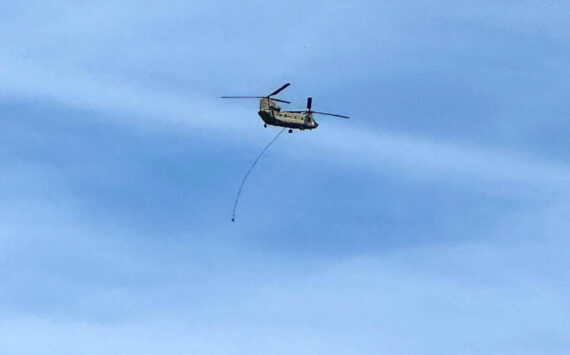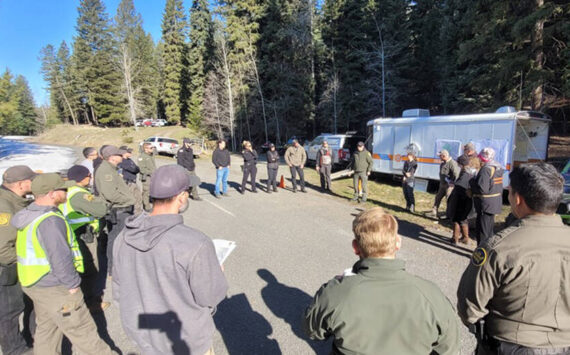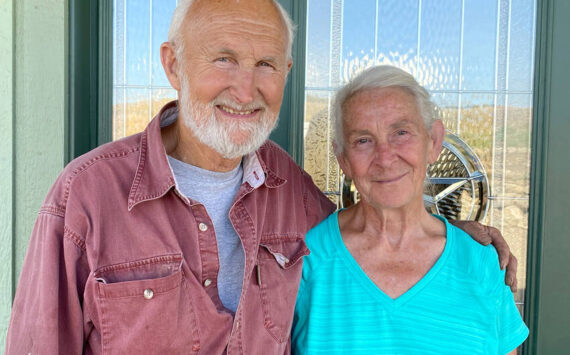“We take the larger 30,000 foot viewpoint, and see what happens in one community that affects all,” Jennifer Korfiaitis, Administrator, NCW Economic Development District
Utilize existing heavy haul corridor to export goods to Canada, create jobs
OROVILLE – Jennifer Korfiatis of the North Central Washington Economic Development District was on hand to discuss the NCWEDD with the Oroville Council at their Tuesday, April 1 meeting.
Korfiatis said her group was a federally designated economic development agency serving Okanogan, Chelan and Douglas counties and the Colville Confederated Tribes.
“We take the larger, 30,000 foot, viewpoint and see what happens in one community affects all,” said Korfiatis.
Before coming to the meeting she took a quick trip around town and north of the border with Chris Branch, Oroville’s Director of Community Development, who is vice chairman on the group’s board.
“What the NCWEDD does is a very important voice in what we do,” said Branch.
Korfiatis said the EDD has been concentrating on three things recently: entrepreneurship, electric vehicles and regional tourism.
Entrepreneurship: “We’ve been focusing on mentorship… They’ve (mentors) been there done that. We team them up and stand back. This has resulted in lots of success,” she said.
One success came from teaming an East Wenatchee beer brewer with a local wine maker who had a lot to share about similar business models, according to Korfiatis.
Electric Vehicles: “There have been five charging stations installed on private property. These are from a catalyst of federal funding along the I-5 corridor and into the Methow Valley,” she said.
Research shows that early adopters of electric vehicles are high dollar tourist and that there is a lot of high use of these vehicles in the Puget Sound area, according to Korfiatis.
By expanding the numbers of charging stations into the regions in the NCWEDD it will be good for the economy, she said. The group is working on a map showing availability of the charging station and developing a mobile app. Omak has the closest charging station to Oroville, but there is also one in Waterville and in the Methow Valley.
“It makes sense… North Central Washington really has the low power rates that are really conducive to electric vehicles.
Regional Tourism: “We are working with Washington State University to study where the high dollar tourists are and what would bring them here,” she said.
Branch Reports
The Community Development Director updated the council on a couple of issues, the Regional Transportation Planning Organization (RTPO) and a move to expand the Heavy Haul Corridor, as well as giving a report on the downtown tree pruning.
Some of the bigger members of the RTPO, mostly Chelan County and the city of Wenatchee, have suggested a change in who gets a vote in the organization. The matter has been discussed at several previous council meetings. Oroville’s mayor, Chuck Spieth, has been invited to attend the meeting in Twisp with other Okanogan County members.
“As far as the RTPO goes, the Mayor of Twisp has done a lot of footwork and called a meeting in Twisp. There may be a turnover in the south end because of her visits, one with Sen. Parlette and one with the Mayor of Wenatchee,” said Branch.
Okanogan County Commissioner Jim Detro, through Okanogan County Farm Bureau head John Wyss, has been promoting expanding the corridor from Oroville south to as far as Pateros. Branch said Robert Fine has been the region’s contact on cross border issues and was instrumental in developing the corridor between the border and the Oroville railhead.
“We visited with a representative from Gorman Brothers at Oroville Reman and Reload and he said there are now 80 employs, most from Oroville and there is more room for expansion.
Expansion would allow more raw logs, fruit and hog fuel for the Omak mill to go south down Highway 97, according to those promoting expansion.
“Fruit… there is fruit going south to Pateros now, but it is a minimal amount. They (the Canadians) are developing more packing at Winfield, which appears to offset this leaking commodity from going south,” said Branch. “The average family farm in the region is five acres or less and shrinking. It doesn’t amount to a whole lot to the provincial government.”
Timber, that’s a non starter, there are not a lot of raw logs crossing the border and it is my experience that the trucks used currently on the road are adequate and wouldn’t need an expanded heavy haul corridor.”
Branch said hog fuel for the mill could be loaded on trains in Oroville.
“I think the conversation has to be in the region. There’s a potential for Reman and Reload or another company to load for export from the U.S. to Canada,” Branch said.
The downtown tree pruning is being done by volunteers with some help from public works and their bucket truck, according to Branch, one of the volunteers.
“We’ve been doing some heavy cutting while trying not to hammer the trees too hard,” he said. “The PUD is going to take one out that has been interfering with the power lines. One clearly has to go, it is up against a sign and in the wires. The PUD has a replacement though.”
Airport Runway
The city will contract with J.U.B. engineering on the runway sealing project.
“The FAA will allow maintenance work, but not the turn arounds, ramp and tie downs at this time,” said Rod Noel, city superintendent. “If they are incorporated later into the runway shift they might consider them just prior to the shift.
All will have to be done at the time of the shift and all we’ll have to do is add a connector to the ramp. They’ll go along with the seal coating to preserve the runway.
Noel added that next year the city would start a new ALP and decide whether to keep the taxi ways or do a turnaround at that time.
The project will cost approximately $148,000 and will do crack sealing and coating and buy the city more time to get a new plan done.






